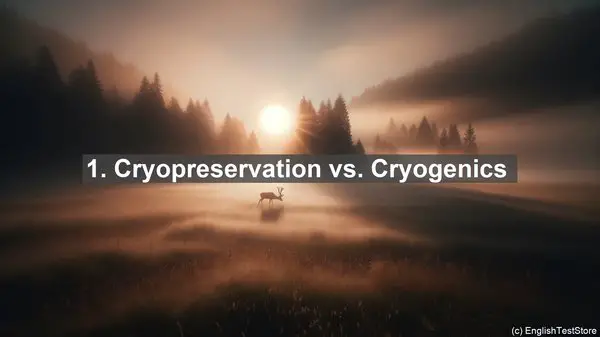Introduction
Welcome to today’s lesson on cryobiology. In this lesson, we’ll be focusing on the top 10 words that often cause confusion in this fascinating field. So, let’s dive in!
1. Cryopreservation vs. Cryogenics
The terms ‘cryopreservation’ and ‘cryogenics’ are often used interchangeably, but they have distinct meanings. Cryopreservation refers to the preservation of biological materials at very low temperatures, while cryogenics is the study of materials at extremely low temperatures. So, cryopreservation is a subset of cryogenics.
2. Vitrification vs. Freezing
Vitrification and freezing are both methods of cryopreservation, but they differ in the formation of ice crystals. Freezing involves the formation of ice crystals, which can damage cells. In contrast, vitrification is a process where a substance solidifies into a glass-like state without crystal formation. It’s often preferred for delicate biological samples.
3. Cryobiology vs. Cryonics
While both terms involve the study of low temperatures, cryobiology and cryonics have distinct focuses. Cryobiology is the branch of biology that deals with the effects of low temperatures on living organisms, while cryonics is the practice of preserving human bodies or brains at very low temperatures with the hope of future revival.
4. Desiccation vs. Dehydration
Desiccation and dehydration both refer to the removal of water, but in different contexts. Desiccation is the drying of a material, often to preserve it, while dehydration is the loss of water from a living organism. So, desiccation is a deliberate process, whereas dehydration can be a natural occurrence.
5. Cryoprotectant vs. Antifreeze
Cryoprotectants and antifreeze compounds are used in cryobiology, but they have different functions. Cryoprotectants are substances that protect cells from damage during freezing, often by reducing ice crystal formation. Antifreeze compounds, on the other hand, lower the freezing point of a solution, preventing ice formation.
6. Revival vs. Reanimation
Revival and reanimation are terms often associated with cryonics, but they have different implications. Revival refers to the restoration of life or biological function, while reanimation is the restoration of consciousness or activity. In the context of cryonics, the ultimate goal is revival, not just reanimation.

7. Cryostorage vs. Cryopreservation
Cryostorage and cryopreservation are related but distinct concepts. Cryopreservation refers to the process of preserving biological materials at low temperatures, while cryostorage is the storage of these materials at those temperatures. So, cryostorage is the physical act of storing, while cryopreservation is the overall process.
8. Cold-resistant vs. Cold-tolerant
When it comes to organisms, cold-resistant and cold-tolerant are often used interchangeably, but they have different meanings. Cold-resistant organisms can withstand low temperatures without significant damage, while cold-tolerant organisms can survive in cold environments, but they may still experience some damage or reduced activity.

9. Cryobiota vs. Cryofauna
Cryobiota and cryofauna are terms used to describe organisms in cold environments, but they have different scopes. Cryobiota refers to all forms of life in cold regions, including plants, animals, and microorganisms. Cryofauna, on the other hand, specifically refers to the animal life in these regions.
10. Cryoprobe vs. Cryosurgery
Cryoprobe and cryosurgery are techniques used in medical procedures, but they serve different purposes. A cryoprobe is a device used to measure temperatures or obtain samples in extremely cold environments. Cryosurgery, on the other hand, is a surgical technique that uses extreme cold to destroy abnormal tissues, like tumors.
